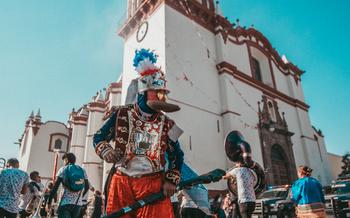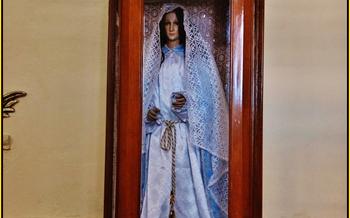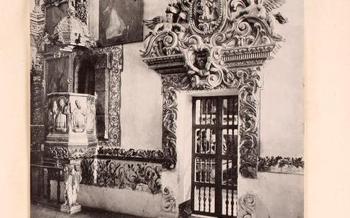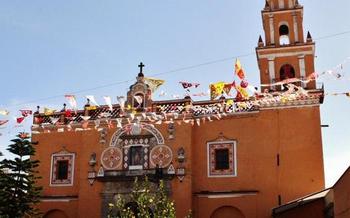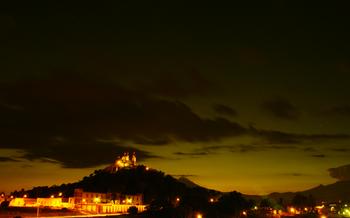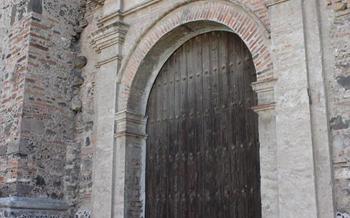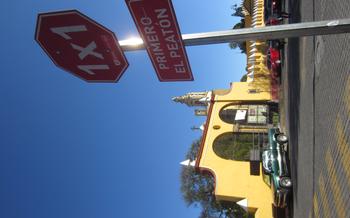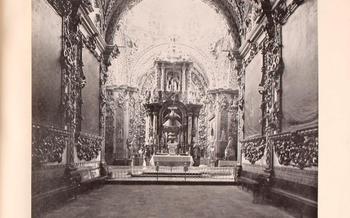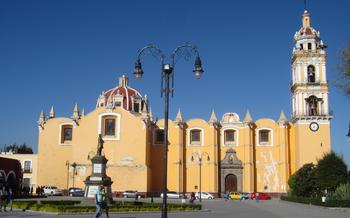
Chapel of the Third Order of San Francisco
- The Majestic Chapel of Cholula: A Historical Overview
- The Chapel's Extraordinary Murals: An Art Masterpiece
- The Healing Powers of the Chapel: A Center of Miracles
- The Altar and the Virgin of the Remedies: A Sacred Icon
- The Chapel Grounds and the Surrounding Area: A Place of Beauty
- Visiting the Chapel: Practical Tips for Pilgrims and Visitors
- Best Time to Visit
- Tips for Exploring the Chapel and Its Grounds
- Dress Code and Other Considerations
- Exploring the City of Cholula: Beyond the Chapel's Walls
- The Archaeological Significance of Cholula: A Mesoamerican Heritage
- The Legend of Quetzalcoatl: A Divine Connection
- The Chapel's Role in the Spanish Conquest: A Crossroads of Faith
- The Chapel's Restoration and Preservation: A Labor of Love
- Events and Festivals at the Chapel: A Celebration of Faith
- Local Cuisine and Handicrafts: A Taste of Cholula
- Accommodations and Transportation: Planning Your Visit
- Insider Tip: Explore the Hidden Gems of Cholula
The Majestic Chapel of Cholula: A Historical Overview
In the heart of Cholula, Mexico, stands a testament to faith and artistry—the Chapel of the Third Order of San Francisco. Its history is as rich and diverse as the city itself, dating back to the 16th century. Originally conceived as a modest hermitage, the chapel underwent a series of expansions and renovations, culminating in the magnificent structure that stands today. The architectural style blends Gothic and Renaissance elements, creating a harmonious fusion that reflects the city's unique heritage.
Beyond its architectural significance, the chapel holds immense cultural and religious value. It represents the deep-rooted faith of the local community, serving as a place of worship, pilgrimage, and spiritual solace. Numerous legends and anecdotes surround the chapel, adding to its mystique and attracting visitors from far and wide. Prepare to be captivated by the chapel's captivating history, intricate design, and the profound impact it has had on the community throughout the centuries.
The Chapel's Extraordinary Murals: An Art Masterpiece
Creation and Restoration of the Murals: The magnificent murals adorning the Chapel of the Third Order of San Francisco were skillfully painted over several decades by renowned artists. The exact time frame of their creation is uncertain, but they are believed to have been crafted between the 16th and 17th centuries. However, the passage of time and exposure to the elements took their toll, leading to the murals' deterioration. Fortunately, meticulous restoration efforts were undertaken in the 19th and 20th centuries, bringing these masterpieces back to their former glory.
Symbolism and Biblical Scenes Depicted: The murals showcase a captivating array of biblical scenes and iconography, serving as a visual testament to the faith and beliefs of the chapel's founders. They depict stories from the Old and New Testaments, including the creation of the world, the life and crucifixion of Jesus Christ, and the final judgment. The murals' vibrant colors and intricate details bring these biblical narratives to life, creating a profound sense of sacredness and awe within the chapel.
Artistic Techniques and Styles Used: The artists employed a variety of techniques and styles to create the murals. The use of tempera, a traditional painting method involving pigments mixed with egg yolk, resulted in the murals' rich and vibrant hues. The artists demonstrated remarkable skill in depicting human figures, capturing their expressions and emotions with great detail and realism. The murals also showcase intricate decorative elements, such as floral motifs and geometric patterns, which further enhance their visual appeal.
Unique Features That Set the Murals Apart: What truly distinguishes the murals of the Chapel of the Third Order of San Francisco is their unique blend of indigenous and European artistic influences. The murals incorporate elements of both cultures, creating a distinctive visual language that reflects the chapel's historical significance as a meeting point between two worlds. This fusion of artistic traditions resulted in a style that is both visually stunning and historically significant, making the murals a must-see for any visitor to Cholula.
The Healing Powers of the Chapel: A Center of Miracles
Since its inception, the Chapel of the Third Order of San Francisco has been renowned as a sacred site with extraordinary healing powers. Over the centuries, countless stories of miraculous healings and answered prayers have been attributed to the chapel, attracting pilgrims and visitors from far and wide seeking solace and divine intervention.
Historical accounts document instances of individuals suffering from various ailments who were miraculously cured within the chapel's hallowed walls. A particularly well-known case is that of a woman afflicted with a debilitating illness who was carried into the chapel on a stretcher. After fervent prayers and supplications to the Virgin of the Remedies, she was miraculously healed, able to walk out of the chapel without any assistance.
The chapel's healing powers are deeply ingrained in the local culture and tradition. It is believed that the sacred atmosphere and the presence of the Virgin of the Remedies create a potent energy field that facilitates healing and spiritual transformation. Many visitors to the chapel have shared their personal experiences of feeling a profound sense of peace, serenity, and healing while within its precincts.
The chapel's reputation as a place of miracles has made it a significant pilgrimage site for those seeking divine healing. People from all walks of life, regardless of their religious affiliations, come to the chapel to pray, offer votive offerings, and seek solace in times of distress. The chapel's healing powers are not limited to physical ailments; it is also believed to offer spiritual healing and guidance to those in need.
The Altar and the Virgin of the Remedies: A Sacred Icon
At the heart of the Chapel of the Third Order of San Francisco lies a sacred icon that draws countless pilgrims and visitors year after year: the altar of the Virgin of the Remedies. This magnificent altar, adorned with intricate carvings and golden embellishments, serves as a focal point of devotion and reverence within the chapel's hallowed halls.
The history of the Virgin of the Remedies is deeply intertwined with the origins of the chapel itself. According to legend, a humble indigenous woman named María Mixcóatl experienced a miraculous vision of the Virgin Mary in the early 1540s. In this vision, the Virgin instructed María to build a chapel on the site where she had appeared. María heeded the Virgin's call, and the chapel was constructed at the foot of the Great Pyramid of Cholula.
Over the centuries, the chapel became a renowned pilgrimage site, and the devotion to the Virgin of the Remedies grew exponentially. The Virgin is believed to possess miraculous healing powers, and countless stories of answered prayers and miraculous cures have been attributed to her intercession.
The iconography of the Virgin of the Remedies portrays her as a compassionate and benevolent figure, radiating an aura of divine grace. She is often depicted holding the Christ Child in her arms, symbolizing her role as the mother of Jesus and her intercession on behalf of humanity.
The altar of the Virgin of the Remedies is a testament to the enduring faith and devotion of the people of Cholula. It is a place where prayers are offered, miracles are sought, and the divine presence is felt. Whether you are a devout pilgrim or simply a curious traveler, the altar of the Virgin of the Remedies is a must-see destination, inviting you to experience the sacred essence of this remarkable chapel.
The Chapel Grounds and the Surrounding Area: A Place of Beauty
Beyond the chapel's walls, visitors are greeted by a serene and picturesque landscape. The chapel grounds boast meticulously manicured gardens, adorned with vibrant flowers, lush greenery, and tranquil fountains. These gardens offer a sanctuary for reflection and contemplation, inviting visitors to immerse themselves in the beauty and serenity of the surroundings.
The surrounding area, known as the Barrio de San Miguel Tianguiznahuac, is a treasure trove of historical and cultural significance. Narrow cobblestone streets wind their way through the neighborhood, leading to charming plazas and courtyards. Visitors can explore the area's many shops, boutiques, and restaurants, where they can find unique souvenirs and savor delicious local cuisine.
The chapel's presence has played a significant role in shaping the identity and culture of the local community. The chapel has served as a gathering place for religious celebrations, festivals, and community events throughout the centuries. It has also been a source of inspiration and guidance for the local people, who hold it in deep reverence and affection.
Overall, the chapel grounds and the surrounding area offer visitors a glimpse into the rich history, culture, and beauty of Cholula. Whether seeking spiritual fulfillment, historical exploration, or simply a moment of tranquility, visitors will find solace and inspiration within this sacred space.
Visiting the Chapel: Practical Tips for Pilgrims and Visitors
Best Time to Visit
For the most optimal experience, plan your visit during the chapel's annual festival, held from September 1st to September 8th. This vibrant celebration attracts thousands of pilgrims and visitors, offering a unique opportunity to immerse yourself in the chapel's rich traditions and witness the fervent devotion of the faithful.
Tips for Exploring the Chapel and Its Grounds
- Allow ample time to explore the chapel and its grounds, as there's much to see and appreciate.
- Wear comfortable shoes, as you'll be doing a lot of walking.
- Be respectful of the chapel's sacred nature and maintain silence when inside.
- Photography is permitted, but be mindful of not using flash or disturbing other visitors.
- Guided tours are available for a more in-depth understanding of the chapel's history and significance.
Dress Code and Other Considerations
- Dress modestly and respectfully when visiting the chapel. Shorts, tank tops, and revealing clothing are not appropriate.
- Be mindful of local customs and traditions, and avoid any behavior that may be considered offensive or disrespectful.
- The chapel is wheelchair accessible, and ramps are available for easy navigation.
With these practical tips in mind, you can ensure a smooth and rewarding visit to the Chapel of the Third Order of San Francisco, creating lasting memories of your pilgrimage or exploration of this sacred and historic site.
Exploring the City of Cholula: Beyond the Chapel's Walls
The city of Cholula extends a warm invitation to travelers to delve into its multifaceted charm beyond the confines of the revered Chapel of the Third Order of San Francisco. As you wander through its cobbled streets, the essence of history, culture, and vibrant traditions unfolds before your eyes.
Discover the captivating murals and intricate mosaics adorning the walls of ancient churches, each narrating tales of the city's rich heritage. Immerse yourself in the bustling markets, where the aroma of traditional delicacies mingles with the lively chatter of locals bartering for goods. Let the rhythm of Cholula's vibrant music and dance captivate your senses as you witness colorful festivals and processions that honor the city's patron saints.
For a taste of culinary delight, savor the mouthwatering flavors of Cholula's traditional dishes, prepared with love and fresh ingredients. From the savory delights of mole poblano to the sweet temptations of churros, your taste buds will embark on a culinary adventure.
Venture beyond the city center and explore the surrounding region, where natural wonders await. Hike to the top of the Great Pyramid of Cholula, the largest pyramid in the world by volume, and marvel at the panoramic views that stretch for miles. Immerse yourself in the tranquility of the nearby La Malinche National Park, where lush forests and cascading waterfalls provide a breathtaking backdrop for outdoor enthusiasts.
Cholula's vibrant cultural scene is further enriched by its thriving art community. Visit local galleries and workshops to admire the works of talented artists and artisans who draw inspiration from the city's rich history and traditions. Engage with the friendly locals, who are always eager to share their stories and insights into the essence of Cholula.
As you bid farewell to this enchanting city, the memories you create here will linger long after your departure. Cholula's unique blend of history, culture, and natural beauty will forever hold a special place in your heart.
The Archaeological Significance of Cholula: A Mesoamerican Heritage
Cholula, a city steeped in history, boasts a rich Mesoamerican heritage that predates the arrival of the Spanish. The ancient city of Cholula, once a flourishing metropolis, was a significant religious and cultural center for the indigenous peoples of the region.
The Great Pyramid of Cholula, also known as Tlachihualtepetl, stands as a testament to the architectural prowess of the ancient Cholulans. This colossal pyramid, the largest in the world by volume, is a marvel of engineering and a symbol of the city's former glory. Its construction involved millions of adobe bricks, and its design reflects the advanced mathematical and astronomical knowledge of the ancient builders.
Archaeological excavations at Cholula have unearthed a wealth of artifacts, including pottery, jewelry, and sculptures. These findings have shed light on the daily lives, beliefs, and customs of the ancient inhabitants. The discovery of numerous temples and shrines within the city further underscores its religious significance, as Cholula was once a major pilgrimage site for Mesoamerican peoples.
The Chapel of the Third Order of San Francisco, with its unique blend of indigenous and Catholic elements, serves as a living testament to the city's rich cultural heritage. Its construction on the site of a pre-Columbian temple reflects the merging of two distinct belief systems and the enduring influence of the ancient past on modern-day Cholula.
The Legend of Quetzalcoatl: A Divine Connection
In the realm of ancient Mexican mythology, the name Quetzalcoatl echoes with tales of a revered deity, a feathered serpent god whose legend intertwines with the story of Cholula and the Chapel of the Third Order of San Francisco. Quetzalcoatl, embodying wisdom, knowledge, and creation, played a pivotal role in shaping the spiritual and cultural identity of Mesoamerican civilizations.
Legends speak of Quetzalcoatl's arrival in Cholula, where he imparted his divine wisdom to the people, teaching them about agriculture, astronomy, and the arts. He is said to have built the Great Pyramid of Cholula, a testament to his architectural prowess and connection to the land. The pyramid's alignment with the stars and its significance as a sacred site further solidified Quetzalcoatl's status as a divine being.
The Chapel of the Third Order of San Francisco, erected on the site of an ancient temple dedicated to Quetzalcoatl, bears witness to the enduring legacy of this revered deity. The chapel's construction in the 16th century marked a significant moment in the blending of indigenous beliefs with Catholicism, as the Spanish sought to establish their religious dominance in the region.
To this day, the legend of Quetzalcoatl remains deeply intertwined with the identity of Cholula and its sacred sites. Locals and visitors alike pay homage to the feathered serpent god, seeking his blessings, wisdom, and guidance. The chapel stands as a testament to this enduring connection, a place where the divine and the earthly converge, embodying the rich cultural heritage of Mexico.
The Chapel's Role in the Spanish Conquest: A Crossroads of Faith
The arrival of the Spanish conquistadors in the 16th century marked a significant turning point in the history of Cholula and the region. The chapel, a symbol of pre-Columbian spirituality, became a focal point in the clash between two worlds. The Spanish, driven by their religious zeal, sought to convert the indigenous population to Catholicism, viewing the chapel as a site of pagan worship. The chapel's transformation into a Catholic church represented a symbolic victory for the Spanish, solidifying their religious and political authority.
The chapel's architecture and iconography were adapted to reflect the new religious order. Indigenous symbols and motifs were replaced with Catholic imagery, blending the two cultures in a unique artistic expression. This fusion of beliefs gave rise to a syncretic religious practice, where elements of both indigenous and Catholic traditions coexisted. The chapel became a melting pot of faith, where the indigenous people could maintain a connection to their ancestral beliefs while embracing the new religion.
The chapel's role in the Spanish conquest extended beyond its religious significance. It served as a strategic location for the Spanish to consolidate their power and control the region. The chapel's proximity to the Great Pyramid of Cholula, a sacred site for the indigenous people, allowed the Spanish to exert their influence over a vast territory. The conquest of Cholula and the transformation of the chapel marked a pivotal moment in the history of Mexico, shaping the religious and cultural landscape of the country.
The Chapel's Restoration and Preservation: A Labor of Love
The passage of time and the elements can take a toll on even the most resilient structures, and the Chapel of the Third Order of San Francisco is no exception. Over the centuries, the chapel has undergone several restoration and preservation projects to ensure its longevity and maintain its historical integrity.
One of the most significant restoration efforts was undertaken in the 19th century when the chapel's roof was in danger of collapsing. The entire roof was dismantled and rebuilt using traditional techniques and materials, ensuring that the chapel's architectural integrity was preserved.
In the 20th century, the chapel underwent further restoration work, focusing on the murals and interior decorations. Expert conservators meticulously restored the vibrant colors and intricate details of the murals, bringing them back to their original splendor.
Preserving the chapel is a labor of love for the local community and organizations dedicated to safeguarding Mexico's cultural heritage. Through their tireless efforts, the chapel continues to stand as a testament to the enduring spirit of Cholula and the importance of preserving its historical landmarks for future generations.
Events and Festivals at the Chapel: A Celebration of Faith
Throughout the year, the Chapel of the Third Order of San Francisco comes alive with a vibrant array of religious festivals and celebrations. These events offer a unique glimpse into the deep-rooted faith and traditions of the local community.
One of the most significant festivals is the annual feast of Our Lady of the Remedies, held every September 8th. This grand celebration draws thousands of pilgrims and visitors from all over the region. The day is marked by colorful processions, traditional dances, and heartfelt prayers, as devotees pay homage to the Virgin and seek her blessings.
Another notable event is the Holy Week procession, which takes place during the week leading up to Easter. This solemn and moving procession reenacts the Passion of Christ, with participants carrying life-sized statues of Jesus and the Virgin Mary through the streets of Cholula. The procession culminates in a touching ceremony at the chapel, where the faithful gather to reflect on the sacrifice and resurrection of Christ.
These festivals and celebrations are not merely religious observances but also important cultural events that bring the community together. They showcase the rich traditions, artistry, and devotion that are deeply embedded in the heart of Cholula's identity.
Local Cuisine and Handicrafts: A Taste of Cholula
Cholula's culinary scene is a vibrant tapestry of flavors and aromas, showcasing the region's rich heritage. Savor traditional dishes like "mole poblano," a complex sauce made with chiles, spices, and chocolate, often served with chicken or pork. Indulge in "tacos al pastor," thinly sliced pork marinated in achiote and grilled on a vertical spit. Don't miss the local street food, such as "tlayudas," large tortillas topped with beans, meat, and cheese, and "chalupas," small fried tortillas covered with various toppings.
For a culinary adventure, head to the local markets, such as the Mercado Municipal Cosme del Razo, a bustling hub of activity where you can find fresh produce, spices, and traditional ingredients. Here, you can interact with friendly vendors and learn about the local cuisine.
Cholula is also renowned for its vibrant handicrafts. The city's artisans create exquisite pottery, hand-woven textiles, and intricate silver jewelry. Visit local workshops and galleries to witness the artisans at work and purchase unique souvenirs to cherish your visit.
By supporting the local food and handicraft industries, you contribute to the sustainability of Cholula's economy while immersing yourself in the authentic cultural experiences that make this city so special.
Accommodations and Transportation: Planning Your Visit
Planning a trip to Cholula doesn't have to be a hassle. The city offers a variety of hotel and accommodation options to suit every taste and budget. From cozy B&Bs to luxurious haciendas, you're sure to find the perfect place to rest your head after a day of exploring.
Once you're settled in, getting around Cholula is a breeze. The city's compact size makes it easy to navigate on foot, and there's a reliable public transportation system to take you to nearby attractions. However, if you prefer the freedom and flexibility of your own vehicle, rental cars are readily available.
When planning your itinerary, allow ample time to explore the Chapel of the Third Order of San Francisco and other historical sites in Cholula. Allocate a day or two for day trips to the surrounding region, where you can discover ancient ruins, charming towns, and breathtaking natural landscapes.
With its rich history, vibrant culture, and warm hospitality, Cholula is a destination that will leave you enchanted. Whether you're a history buff, a nature lover, or simply seeking a unique and authentic travel experience, this city has something to offer everyone.
Insider Tip: Explore the Hidden Gems of Cholula
While the Chapel of the Third Order of San Francisco is undoubtedly the star attraction of Cholula, the city holds many more treasures waiting to be discovered. Venture beyond the chapel walls and explore the hidden gems that reveal the true essence of this vibrant city. Stroll through the bustling local markets, where you can haggle for unique handicrafts, savor the tantalizing aromas of street food, and witness the vibrant daily life of the Cholultecas. Immerse yourself in the city's rich history by visiting lesser-known historical sites, such as the Ex-Convent of San Gabriel, which houses a fascinating collection of colonial-era artifacts and art. Engage with the friendly locals, who are always eager to share stories and insights about their beloved city. By stepping off the beaten path, you'll uncover the authentic soul of Cholula, creating a truly immersive and unforgettable travel experience.
